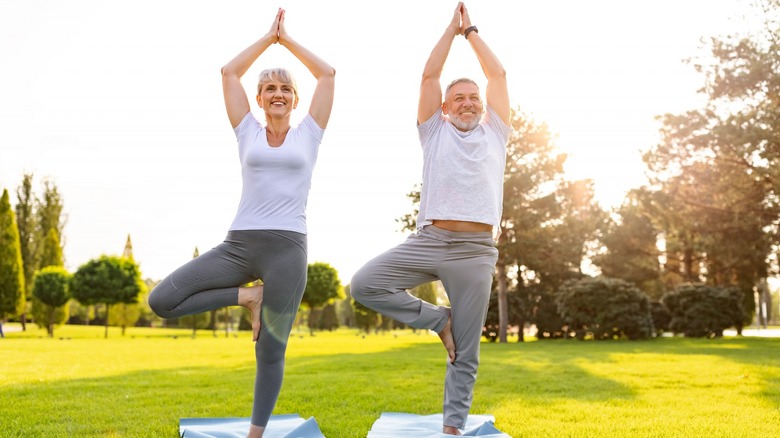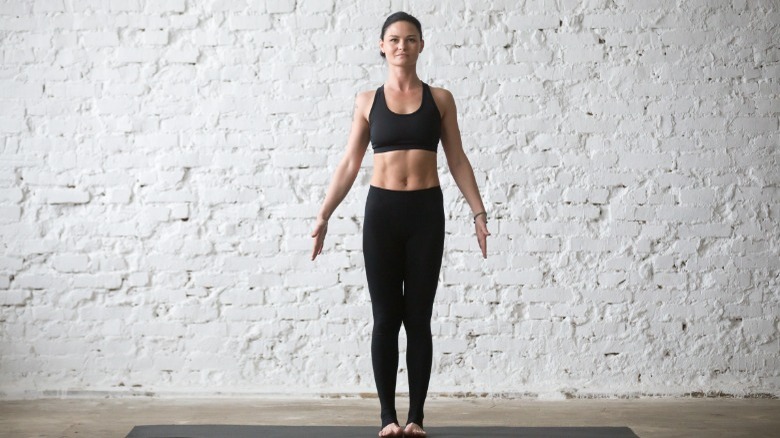The Benefits Of Doing Tree Pose In Yoga
If your morning routine consists of downward-facing dogs, warrior ones, and tree poses, you're in good, limber company. The popularity of yoga in the United States has been on the rise over the past several decades. Some 34.4 million American adults practiced yoga in 2021, with about 25% of yoga practitioners surveyed reporting they also own a yoga mat, according to Statista.
The physical and mental health benefits of yoga are multifold for people of all ages. When practiced on a consistent basis, yoga can potentially improve blood flow, ease back pain, increase mobility, reduce stress and inflammation, help you to get a better night's sleep, and build your strength and flexibility, explains Johns Hopkins Medicine. Additionally, yoga can help improve balance, which tends to become challenging as we age, per the National Institute on Aging.
Tree pose, also known by the Sanskrit term vrikshasana (derived from "vriksha," the word for tree, and "asana," meaning "pose"), is excellent for stretching your thigh and groin muscles, building ankle strength, and improving balance and stability, as Ortho Carolina explains. To get into tree pose, anchor one leg into the floor and place your other foot against your inner thigh. Once you establish your balance, try to raise your hands over your head like a tree. Hold for at least 30 seconds and then repeat the pose with the opposite leg, per MasterClass. For more of a challenge during the pose, close your eyes. Expect to wobble and possibly even fall out of the pose. That's perfectly okay! Tree pose looks simple, but it's surprisingly challenging.
Tree pose risks
While tree pose is an excellent yoga posture to help you become more steady, there are certain situations when you should avoid practicing the pose. Due to the nature of the posture challenging your balance, if you ever feel lightheaded or have low blood pressure, the experts at Everyday Yoga advise that you stay away from tree pose. Additionally, if you have a headache or have not been sleeping well, these are also situations when practicing tree pose is not advisable. If you have other health issues that may compromise your ability to do a tree pose — or any other yoga poses for that matter — talk to your doctor first to discuss any potential risks.
If you are in good health and can practice tree pose, make sure you are doing the pose correctly to avoid injury. For instance, tree pose requires you to put your weight on all four corners of the foot that is providing stability. However, the Yoga Alignment Guide reports that a common mistake people make in tree pose is leaning on one side of the foot. Also, be careful how you place your hips. Your hips should be even, but if you aren't paying attention, one hip could end up jutting to the side. Perhaps the most important action you need to take to maintain tree pose is engaging your core. Your core maintains your stability in the pose, so keep your abdomen and glutes active while in the posture.
Other yoga balancing postures to try
If you're looking for other balancing poses to include in your practice, there are many yoga postures you can try. For instance, Yoga Basics explains that mountain pose, or tadasana, is an effective, foundational balancing pose. To get into mountain pose, stand on both feet with hips over ankles. Spread your toes, squeeze your thighs, and lift your crown while reaching your fingers toward the earth. Next, inhale your arms up from your sides into an "H" shape while relaxing your shoulders. After four to eight breaths release your arms back down to your sides. It may not seem like much is happening, but the posture requires your body's full engagement. Mastering mountain pose will also help prepare you for other balancing poses.
Balancing table pose is another posture that's accessible to practitioners of all levels. To begin, get down on all fours in a table pose with knees directly under your hips, and hands under your shoulders. Inhale as you extend your left arm out in front and your right leg behind you. Hold this posture for three to six breaths. Release your extended arm and leg on an exhale and return to a neutral tabletop and repeat on the other side, per Yoga Basics.
Looking for a bit more of a challenge? Try chair pose. Squat as if sitting in a chair with your knees together and arms raised. Not only will chair pose improve your balance, but it's also a super way to build upper and lower body strength, per Forbes Health.



